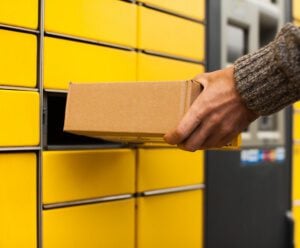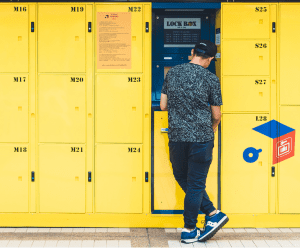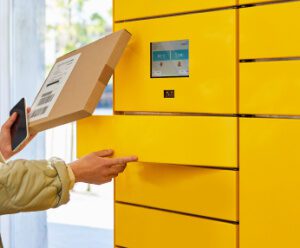
10 questions to ask before setting up a parcel locker network for your business

The Covid-19 pandemic has prompted the rise of new last-mile delivery solutions amid evolving consumer expectations. Apart from speedy deliveries, shoppers are now looking for flexibility and convenience.
As such, an increasing number of businesses in Asia Pacific are setting up smart parcel locker networks to optimize their delivery processes and reduce costs to stay competitive in an evolving market.
A parcel locker network is a system of automated storage units or lockers, typically installed at accessible locations. Integrated with digital monitoring, authentication, and communication systems, each locker is designed to securely store packages and facilitate their efficient drop-off and pick-up.
The advent of parcel locker networks
The benefits of having a parcel locker network are apparent. It can streamline a business’s delivery and retrieval of packages, offering convenience to delivery companies and customers. Its versatility and adaptability of a parcel locker network allow businesses that deliver many packages to improve operational efficiency while enhancing the customer experience.
Parcel locker networks have become increasingly commonplace in e-commerce and retail companies, apartment complexes, office buildings, business parks, educational institutions, co-working spaces, healthcare facilities, hotels, and pharmacy chains. In fact, the parcel locker market in Asia Pacific is expected to triple within the decade, growing from US$134.66 million in 2021 to US$346.68 million by 2028.
However, setting up a parcel locker network comes with its challenges. Beyond setting up physical lockers, the distance between each locker is crucial in determining whether it is effective as a logistics solution. Constructing a parcel locker network means mapping out crucial points within a certain territory that cater to areas with high demand and ensuring that locations have the technological infrastructure to power smart systems. Regular maintenance also needs to be carried out, with the support of help hotlines and security measures to ensure the safety of the customer’s parcels.
Ten questions to ask before establishing a parcel locker network
Parcel locker networks are not a one-size-fits-all solution for all businesses. It may be inadvisable to set up such a system in some situations. Hence, here are 10 things businesses should consider before starting parcel locker networks.
1. Do you understand the need?
Parcel lockers are first and foremost, a large-scale solution. If a business has very low package volumes or infrequent deliveries, investing in a parcel locker network would be impractical as the initial costs associated with setting it up and maintaining the lockers would likely outweigh the benefits.
Clearly define the reasons and objectives for implementing a parcel locker network. Is there a compelling need to improve last-mile delivery efficiency, enhance the customer experience, or reduce delivery costs? Business owners should make sure they have a strong case before they embark on the construction of parcel lockers.
2. Do you understand your target market?
Clearly identify your target customer base for a parcel locker service and focus on areas with higher demand for your products. Businesses can serve their customer base more effectively by strategically planning the locations for placing lockers – in high-traffic areas, residential complexes, commercial spaces, or public facilities.
3. Can you estimate the ideal locker capacity?
Different industries and products may have different requirements for storage. A standard parcel locker system may not be appropriate for businesses that deal with highly- specialized or sensitive deliveries that require unique handling or specialized facilities.
Businesses should determine the appropriate locker sizes for their network based on typical items to be stored, the expected volume of packages, and the average parcel size in the target location.
4. Does your business have the required technology and security?
Security is a key consideration for a parcel locker network. Choose a reliable, secure technology platform to manage the network, including access control systems, monitoring, tracking, and user authentication. Integrate the system with existing logistics and e-commerce platforms to enable seamless communication, tracking, and synchronization of delivery and retrieval.
5. How intuitive and efficient is the user interface and customer experience likely to be?
User experience is essential to getting customers to utilize your parcel locker facilities. Design or adopt an intuitive user interface for customers and administrators to ensure easy parcel drop-off, pick-up, and management of the locker network.
6. What payment and billing mechanisms will you have?
Implement a secure, efficient payment system for customers, considering options such as pay-per-use, subscription models, or integration with existing payment gateways.
7. Do you have service-level agreements in place?
Establish service-level agreements (SLAs) with relevant stakeholders, such as logistics partners, property managers, and end-users. The SLAs will define performance expectations, responsibilities, and service quality standards.
8. Can you comply with all regulations?
Ensure compliance with relevant legislation, regulations, and standards related to accessibility, data privacy, security, and any other factors governing the operation of parcel locker networks.
9. Can you maintain the network?
Companies lacking the necessary technological infrastructure or capabilities will likely find establishing a smart locker network too resource-intensive or technically challenging. Smaller businesses may also face restrictions such as insufficient space to install parcel lockers.
To ensure the quality of the customer’s user experience, businesses need to develop a comprehensive maintenance plan to resolve technical issues and provide timely support to customers, logistics partners, and property managers.
10. Can you adequately train stakeholders?
Setting up a parcel locker network only makes sense if consumers frequently use it. As such, businesses should train all stakeholders – including customers, administrators, and property managers – to ensure the adoption and utilization of the parcel locker network runs smoothly.
By considering these questions carefully, you’ll have the best chance of establishing a parcel locker network that provides value to your business and customers.
ALSO WORTH READING















 English
English